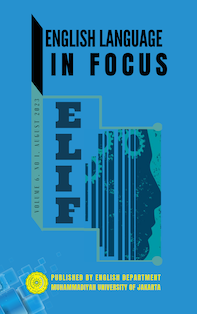Promoting Students Reading Comprehension Through Systemic Functional Linguistics-Reading to Learn (SFL-R2L)
DOI:
https://doi.org/10.24853/elif.6.2.157-168Abstract
This study aims to investigate in detail the process and the result of improving English reading skills through Systemic Functional Linguistics-Reading to Learn (SFL-R2L). This study is an action research conducted in English Department Muhammadiyah University of Jakarta with total amount of participant 30 students within three action research cycles. The data was gathered from the process of observation in participation level and the result of an English reading skills test. The findings showed that the learning process using Systemic Functional Linguistics-Reading to Learn (SFL-R2L) attracted the students to be more active in their learning process, it is showed by their participation level in the learning interaction. The result also presented that students’ English reading skill were a significantly improved. It can be concluded that the use of Systemic Functional Linguistics-Reading to Learn (SFL-R2L) succeeded in improving student English reading skills.References
Aliponga, J. (2013). Reading journal: its benefits for extensive reading. International Journal of Humanities and Social Science, 3(12), 73-80.
Bazerman, Charles, Adair Bonini, & Débora Figueiredo (Eds.). (2009). Genre in a Changing World. The WAC Clearinghouse; Parlor Press. https://doi.org/10.37514/PER-B.2009.2324
Brown, H. D., & Abeywickrama, P. (2004). Language assessment: Principles and Classroom Practices. White Plains, NY: Pearson Education.
Carter, C. E. (2012). Landscapes: Groundwork for College Reading. USA: Cengage Learning.
Cohen, A. D., & Macaro, E. (Eds.). (2007). Language Learner Strategies: Thirty Years of Research and Practice. Oxford, England: Oxford University Press.
Grabe, W., & Stoller, F. L. (2019). Teaching and researching reading. Routledge.
Eggins, S. (2004). Introduction to systemic functional linguistics. A&c Black.
Emilia, E. (2022). Pendekatan Berbasis Teks (Genre-Based Approach) dalam Pengajaran Bahasa Inggris: Petunjuk untuk guru. Kiblat Buku Utama.
Halliday, M. A. K., & Matthiessen, C. (2006). Construing experience through meaning: A language-based approach to cognition. A&C Black.
Knapp, P., & Watkins, M. (2005). Genre, text, grammar: Technologies for teaching and assessing writing. UNSW Press.
Martin, J. R., & Rose, D. (2003). Working with discourse: Meaning beyond the clause. Bloomsbury Publishing.
Mokhtari, K., & Sheorey, R. (2008). Reading Strategies of First-and Second-Language Learners: See How They Read. Norwood, MA: Christopher-Gordon Publishers.
Nunan, D. (2004). Task-Based Language Teaching. New York: Cambridge University Press.
Oakhill, J., Cain, K., & Elbro, C. (2014). Understanding and Teaching Reading Comprehension: A Handbook. New York: Routledge
Rose, D. (2006). Reading genre: A new wave of analysis. Linguistics and the human sciences, 2(2), 185.
Coltheart, M., Snowling, M. J., & Hulme, C. (2005). The science of reading: A handbook. Blackwell Publishing Ltd
Unsworth, L. (Ed.). (2005). Researching language in schools and communities: Functional linguistic perspectives. A&C Black.
Woolley, G. (2011). Reading Difficulties. Reading Comprehension: Assisting Children with Learning Difficulties. New York: Springer Science. https://doi.org/10.1007/978-94-007-1174-7_1
Downloads
Published
Issue
Section
License
Authors who publish with this journal agree to the following terms:
- Authors retain copyright and grant the journal right of first publication with the work simultaneously licensed under a Creative Commons Attribution License that allows others to share the work with an acknowledgment of the work's authorship and initial publication in this journal.
- Authors can enter into separate, additional contractual arrangements for the non-exclusive distribution of the journal's published version of the work (e.g., post it to an institutional repository or publish it in a book), with an acknowledgment of its initial publication in this journal.
- Authors are permitted and encouraged to post their work online (e.g., in institutional repositories or on their website) before and during the submission process, as it can lead to productive exchanges, as well as earlier and greater citation of published work (See The Effect of Open Access).


